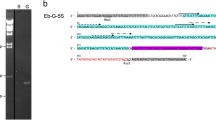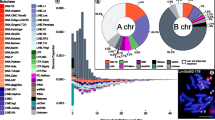Abstract
It is known that in eight hagfishes chromosome elimination occurs during early embryogenesis. The eliminated chromosomes are mostly C-band positive, so that none of the somatic cells have any C-band-positive chromatin. Recently, some highly repetitive DNA sequences have been reported as eliminated elements in these hagfishes based on molecular biological methods. However, no germline-restricted repetitive DNA have been directly isolated from the Japanese hagfish Eptatretus burgeri, from which approximately 21% of the total DNA is eliminated from presumptive somatic cells. Through electrophoretic investigation after digestion with restriction endonucleases, two DNA families that are restricted to germline DNA were isolated. Molecular cloning and sequence analysis revealed that these families are composed of closely related sequences of 64 and 57 bp in length, respectively. Southern blot hybridization revealed that the two DNA families are restricted to germline DNA and were thus named EEEb1 and EEEb2, respectively. Moreover, these eliminated elements were highly and tandemly repeated, and it is predicted that they might amplify by saltatory replication and have evolved in a concerted manner. By densitometric scanning, EEEb1 and EEEb2 were found to amount to make up approximately 18.5 and 0.024% of the total germline genomic DNA, accounting for 88.6% of the total eliminated DNA. A fluorescence in situ hybridization experiment demonstrated that EEEb1 is located on all C-band-positive chromosomes that are limited to germ cells, suggesting that EEEb1 is the primary component of eliminated DNA of E. burgeri.
Similar content being viewed by others
References
Bachmann, L., F. Venazetti & V. Sbordoni, 1996. Tandemly repeated satellite DNA of Dolichopoda schiavazzii: a test for models on the evolution of highly repetitive DNA. J. Mol. Evol. 43: 135–144.
Baltimore, D., 1981. Gene conversion: some implications for immunoglobulin genes. Cell 24: 592–594.
Basten, C.J. & T. Ohta, 1992. Simulation study of a multigene family, with special reference to the evolution of compensatory advantageous mutations. Genetics 132: 247–252.
Boveri, T., 1887. Uber Differenzierung der Zellkerne wahrend der Furchung des Eies von Ascaris megalocephala. Anat. Anz. 2: 688–693.
Britten, R.J. & D.E. Kohne, 1968. Repeated sequences in DNA. Science 161: 529–540.
Dover, G.A., 1982. Molecular drive: a cohesive mode of species evolution. Nature 289: 111–117.
Dover, G.A. & D. Tautz, 1986. Conversion and divergence in multigene families: alternatives to selection and drift. Philos. Trans. R. Soc. Lond. Ser. B 312: 275–289.
Elder, J.F. & B.J. Turner, 1995. Concerted evolution of repetitive DNA sequences in eukaryotes. Q. Rev. Biol. 70: 297–320.
Fan, Q. & M.-C. Yao, 2000. A lomg stringent sequence signal for programmed chromosome breakage in Tetrahymena thermophila. Nucl. Acids Res. 28: 895–900.
Goday, C. & S. Pimpinelli, 1993. The occurrence, role and evolution of chromatin diminution in Nematodes. Parasitol Today 9: 319–322.
Goto, Y., S. Kubota & S. Kohno, 1998. Highly repetitive DNA sequences that are restricted to the germ line in the hagfish Eptatretus cirrhatus: a mosaic of eliminated elements. Chromosoma 107: 17–32.
John, B. & G.L.G. Miklos, 1979. Function aspects of satellite DNA and heterochromatin. Int. Rev. Cytogenet. Cell Genet. 41: 209–214.
Kohno, S., Y. Nakai, S. Satoh, M. Yoshida & H. Kobayashi, 1986. Chromosome elimination in Japanese hagfish, Eptatretus burgeri (Agnatha, Cyclostomata). Cytogenet. Cell Genet. 41: 209–214.
Kohno, S., S. Kubota & Y. Nakai, 1998. Chromatin diminution and chromosome elimination in hagfish species, pp. 81–100 in The Biology of Hagfishes, edited by J.M. Jørgensen, J.P. Lomholt, R.E. Weber & H. Malte. Chapman and Hall, London.
Kubota, S., M. Kuro-o, S. Mizuno & S. Kohno, 1993. Germ line-restricted, highly repeated DNA sequences and their chromosomal localization in a Japanese hagfish (Eptatretus okinoseanus). Chromosoma 102: 163–173.
Kubota, S., T. Ishibashi & S. Kohno, 1997. A germline restricted, highly repetitive DNA sequence in Paramyxine atami: an interspecifically conserved, but somatically eliminated, element. Mol. Gen. Genet. 256: 252–256.
Linares, A.R., T. Bowen & G.A. Dover, 1994. Aspects of nonrandom turnover involved in the concerted evolution of intergenic spacers within the ribosomal DNA of Drosophila melanogaster. J. Mol. Evol. 39: 151–159.
Müller, F., P. Walker, P. Aeby, H. Neuhaus, H. Felder, E. Back & H. Tobler, 1982. Nucleotide sequence of satellite DNA sequence contained in the eliminated genome of Ascaris lumbricoides. Nucl. Acids Res. 10: 7493–7510.
Müller, F., C. Wicky, A. Spicher & H. Tobler, 1991. New telomere formation after developmentally regulated chromosomal breakage during process of chromatin diminution in Ascaris lumbricoides. Cell 67: 815–822.
Nabeyama, M., S. Kubota & S. Kohno, 2000. Concerted evolution of a highly repetitive DNA family in Eptatretidae (Cyclostomata, Agnatha) implies specifically differential homogenization and amplification events in their germ cells. J. Mol. Evol. 50: 154–169.
Nagylaki, T., 1984. The evolution of multigene families under intrachromosomal gene conversion. Genetics 106: 529–548.
Nakai, Y., S. Kubota & S. Kohno, 1991. Chromatin diminution and chromosome elimination in four Japanese hagfish species. Cytogenet. Cell. Genet. 56: 196–198.
Nakai, Y., S. Kobota, Y. Goto, T. Ishibashi, W. Davison & S. Kohno, 1995. Chromosome elimination in three Baltic, south Pacific and north-east Pacific hagfish species. Chrom. Res. 3: 321–330.
Niedermaier, J. & K.B. Moritz, 2000. Organization and dynamics of satellite and telomere DNAs in Ascaris: implications for formation and programmed breakdown of compound chromosomes. Chromosoma 109: 439–452.
Nowak, R., 1994. Mining treasures from ‘junk DNA'. Science 263: 608–610.
Ohta, T., 1990. How gene families evolve. Theor. Popul. Biol. 37: 213–219.
Ojima, Y., 1983. Fish Cytogenetics (in Japanese). Suikohsha, Tokyo.
Shichiri, M., Y. Kikuma, C.-H. Kuo, L.-L. Liu, S. Kubota & S. Kohno, 1997. Chromosome elimination and germ line-restricted microchromosomes in Paramyxine sheni from Taiwan. Chrom. Sci. 1: 49–53.
Singer, M.F., 1982. Highly repeated sequences in mammalian genomes. Int. Rev. Cytol. 76: 67–112.
Smith, G.P., 1976. Evolution of repeated DNA sequences by unequal crossover. Science 191: 528–535.
Southern, E.M., 1970. Base sequence and evolution of guinea pig satellite DNA. Nature 227: 794–798.
Staiber, W., I. Wech & A. Preiss, 1997. Isolation and chromosomal localization of a germ line-specific highly repetitive DNA family in Acricotopus lucidus (Diptera, Chironomidae). Chromosoma 106: 267–275.
Streeck, R.E., K.B. Moritz & K. Beer, 1982. Chromatin diminution in Ascaris suum: nucleotide sequence of the eliminated satellite DNA. Nucl. Acids Res. 10: 3495–3502.
Teschke, C., G. Solleder & K.B. Moritz, 1991. The highly variable pentameric repeats of the AT-rich germline limited DNA in Parascaris univalens are the telomeric repeats of somatic chromosomes. Nucl. Acids Res. 19: 2677–2684.
Tobler, H., 1986. The differentiation of germ and somatic cell lines in Nematodes, pp. 1–69 in Germ Line-soma Differentiation. Results and Problems in Cell Differentiation, Vol. 13, edited by W. Hennig. Springer, Berlin, Heidelberg.
Tobler, H., K.D. Smith & H. Ursprung, 1972. Molecular aspect of chromatin elimination in Ascaris lumbricoides. Dev. Biol. 27: 190–203.
Tobler, H., A. Etter & F. Müller, 1992. Chromatin diminution in nematode development. Trends Genet. 8: 427–431.
Vieira, J. & J. Messing, 1987. Production of single-stranded plasmid DNA. Methods Enzymol. 153: 3–11.
Vogt, P., 1990. Potential genetic functions of tandem repeated DNA sequence blocks in the human genome are based on a highly conserved ‘chromatin folding code'. Hum. Genet. 84: 301–336.
Yao, M.-C., K. Zheng & C.-H. Yao, 1987. A conserved nucleotide sequence at the sites of developmentally regulated chromosome breakage in Tetrahymena. Cell 48: 779–788.
Author information
Authors and Affiliations
Rights and permissions
About this article
Cite this article
Kubota, S., Takano, Ji., Tsuneishi, R. et al. Highly repetitive DNA families restricted to germ cells in a Japanese hagfish (Eptatretus burgeri): a hierarchical and mosaic structure in eliminated chromosomes. Genetica 111, 319–328 (2001). https://doi.org/10.1023/A:1013751600787
Issue Date:
DOI: https://doi.org/10.1023/A:1013751600787




